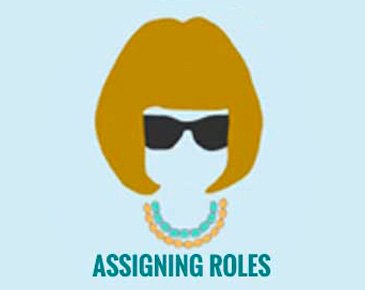With a strategy firmly in place, it is now time to move onto building the team to create the content. We know your team is small. So this is not about the size of your staff. Rather this is about the roles and responsibilities of each participant. Not all of these roles need to be full-time. The quantity and quality of the work you have decided to produce will dictate the number of people required, but the baseline roles and responsibilities remain consistent.
We often think of this as building an internal newsroom. Newspapers and magazines long ago figured out the right way to churn out content quickly and effectively. So we look to their mastheads to create a team structure that encompasses their best practices.
Chief Content Officer aka Editor in Chief
 Every content-producing organization needs a strong person at the helm. Again, this need not be a full-time role, but (as an aside) I do question an organization’s commitment to content creation if it does not at least have this one full-time role. This person is the Anna Wintour of your team. She is responsible for focusing on content strategy, developing goals, determining topics and focal points, leading the development of the initiatives, and putting the structure in place.
Every content-producing organization needs a strong person at the helm. Again, this need not be a full-time role, but (as an aside) I do question an organization’s commitment to content creation if it does not at least have this one full-time role. This person is the Anna Wintour of your team. She is responsible for focusing on content strategy, developing goals, determining topics and focal points, leading the development of the initiatives, and putting the structure in place.
In other words, the buck stops with her.
Content Creators aka Editor
 These are your work horses. These are the people who can translate ideas into messages for various mediums (e.g. articles, infographics, video, white papers, etc). This is your team of impassioned, creative, and knowledgable people looking to make an impact with their pieces. You may have a variety of content creators for different mediums – writers for articles, writers for white papers, video producers, and still photographers. They may be different internal people but they all share the responsibility of creating their individual pieces of content.
These are your work horses. These are the people who can translate ideas into messages for various mediums (e.g. articles, infographics, video, white papers, etc). This is your team of impassioned, creative, and knowledgable people looking to make an impact with their pieces. You may have a variety of content creators for different mediums – writers for articles, writers for white papers, video producers, and still photographers. They may be different internal people but they all share the responsibility of creating their individual pieces of content.
Proof Reader aka Copy Editor
 A proof reader is a second set of eyes. This person might not be immersed in the day-to-day of content creation, but they should have a critical eye and a sharp attention to detail. They don’t necessarily even have to be a writer. They could just be the person in your organization who is a stickler for details, one who David Foster Wallace may classify (lovingly) as a SNOOT. Don’t overlook this role. No matter the content, there is no excuse for sloppiness so find someone who has a sharp set of eyes.
A proof reader is a second set of eyes. This person might not be immersed in the day-to-day of content creation, but they should have a critical eye and a sharp attention to detail. They don’t necessarily even have to be a writer. They could just be the person in your organization who is a stickler for details, one who David Foster Wallace may classify (lovingly) as a SNOOT. Don’t overlook this role. No matter the content, there is no excuse for sloppiness so find someone who has a sharp set of eyes.
Designer aka Layout
 Well written content is certainly crucial. Equally important though, is that it be well designed. The look of the headlines, sub-heads, pull quotes, stats, charts, and the use of typography, font, colors … this all matters. It matters not only for grabbing the attention of your target audience, but also for retaining their attention, and for their absorption of the content. Layout matters. This does not mean that every piece gets a new design treatment every time. Your designer can create templates that will work for 80% of the pieces and be tweaked slightly each time. The other 20% may require more of a white glove treatment given their intended impact and shelf life.
Well written content is certainly crucial. Equally important though, is that it be well designed. The look of the headlines, sub-heads, pull quotes, stats, charts, and the use of typography, font, colors … this all matters. It matters not only for grabbing the attention of your target audience, but also for retaining their attention, and for their absorption of the content. Layout matters. This does not mean that every piece gets a new design treatment every time. Your designer can create templates that will work for 80% of the pieces and be tweaked slightly each time. The other 20% may require more of a white glove treatment given their intended impact and shelf life.
Promotions Manager aka Publisher
 Just because you create some content doesn’t mean it will be consumed by your audience. It is incredibly important to have a Promotions Manager who pushes your content out. Your audience is not destined to simply find it on their own. This person establishes the strategy for distribution, manages the promotional calendar, and has a keen understanding of the various platforms on which your target engages. A core responsibility is translating the content into engaging platform-specific soundbites that command attention.
Just because you create some content doesn’t mean it will be consumed by your audience. It is incredibly important to have a Promotions Manager who pushes your content out. Your audience is not destined to simply find it on their own. This person establishes the strategy for distribution, manages the promotional calendar, and has a keen understanding of the various platforms on which your target engages. A core responsibility is translating the content into engaging platform-specific soundbites that command attention.
Metrics Maven aka Analyst
 We are often asked, what are the right metrics to use to determine the effectiveness of content creation? We always follow up with, what are your goals? Know your goals and you know what to measure. Awareness may mean measuring new site visitors versus returning visitors; engagement may mean looking at number of page views, the time spent on site, the time spent watching a video; loyalty may mean newsletter sign-ups or sharing a social message. There are a multitude of metrics to track and this role needs to align content objectives with the right analytics. Knowing what to measure (and why you’re measuring it) is half the battle. The other half is then applying this knowledge to improving the content for the next round. This Metrics Maven relishes in making recommendations that answer the question, so what? about the data.
We are often asked, what are the right metrics to use to determine the effectiveness of content creation? We always follow up with, what are your goals? Know your goals and you know what to measure. Awareness may mean measuring new site visitors versus returning visitors; engagement may mean looking at number of page views, the time spent on site, the time spent watching a video; loyalty may mean newsletter sign-ups or sharing a social message. There are a multitude of metrics to track and this role needs to align content objectives with the right analytics. Knowing what to measure (and why you’re measuring it) is half the battle. The other half is then applying this knowledge to improving the content for the next round. This Metrics Maven relishes in making recommendations that answer the question, so what? about the data.
Wrapping it up
Clear, delineated roles is the key to building a team of people (no matter how small) who can efficiently and effectively execute on content creation. These six roles will make or break your content creation efforts. Without key people in place to manage these facets of the initiative, you are bound to encounter obstacles that are hard to overcome.
How much content are you producing and how big is your team? Are you spinning your wheels or are things progressing smoothly? If you are struggling, then your team may not be assigned the right roles or your process may be broken.
All of these ideas came out of a presentation we recently gave at the In-House Agency Forum’s Annual Conference focused on “Game Changers”.
Want a copy of our full presentation? Email us at jcosco – at – tippingpointlabs dot com.
